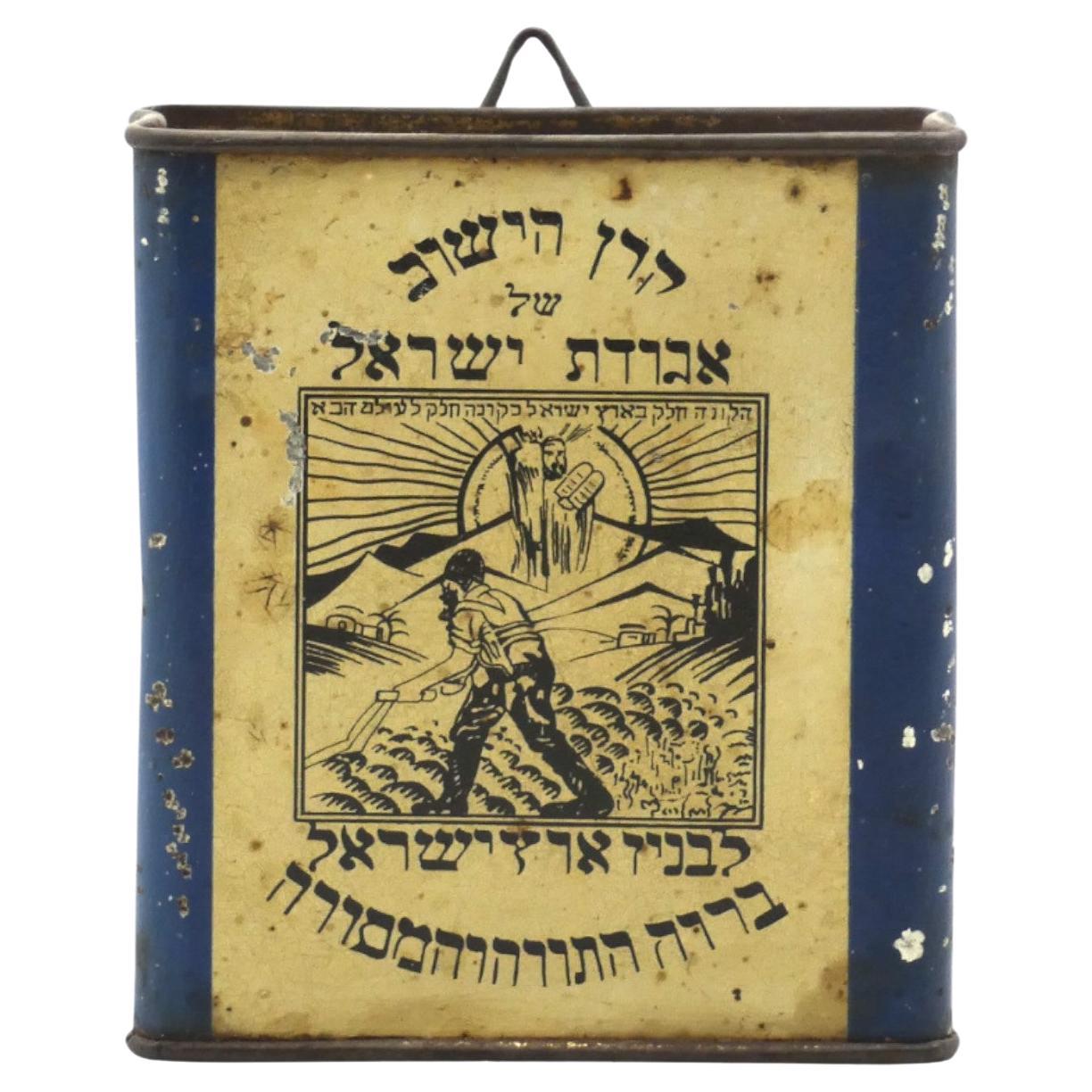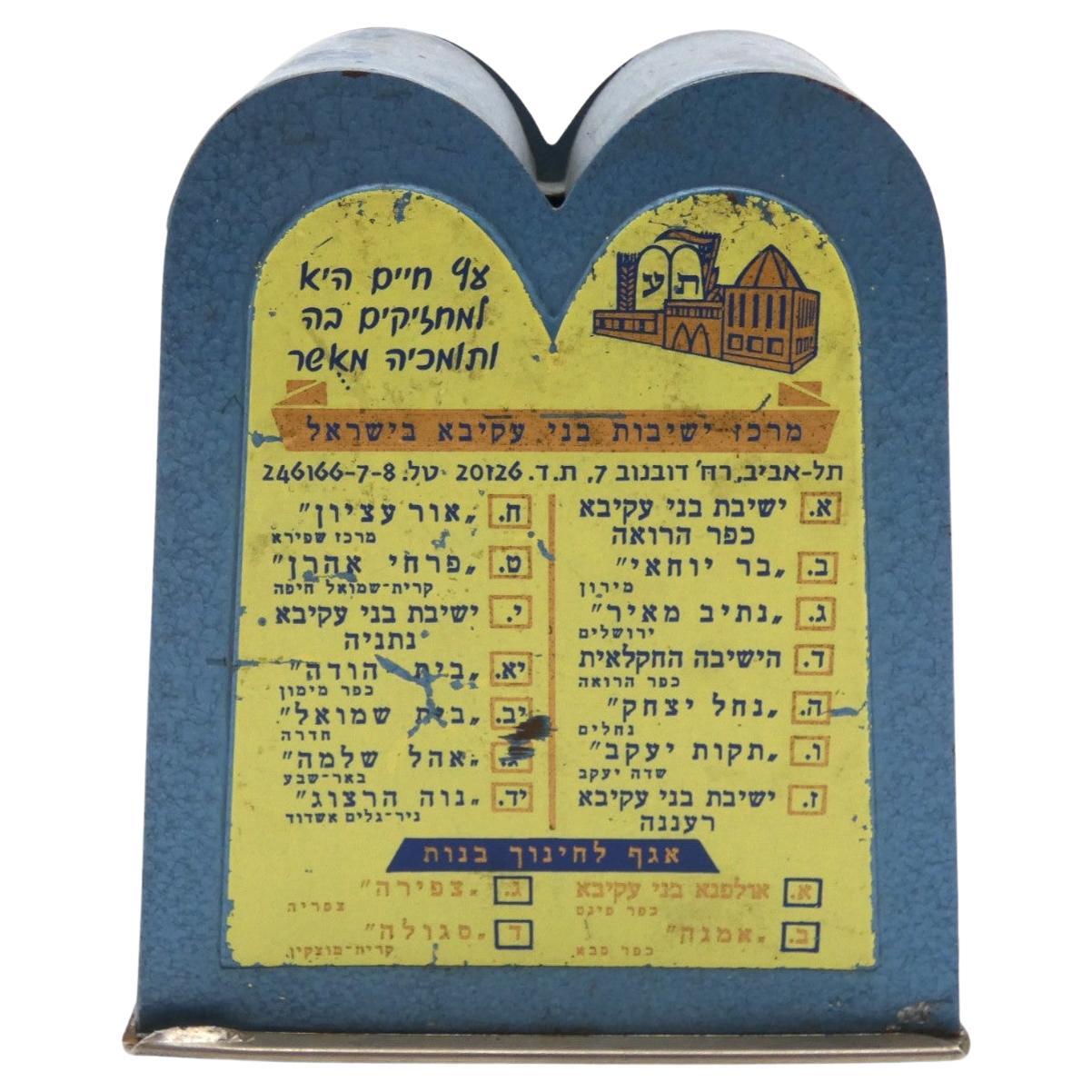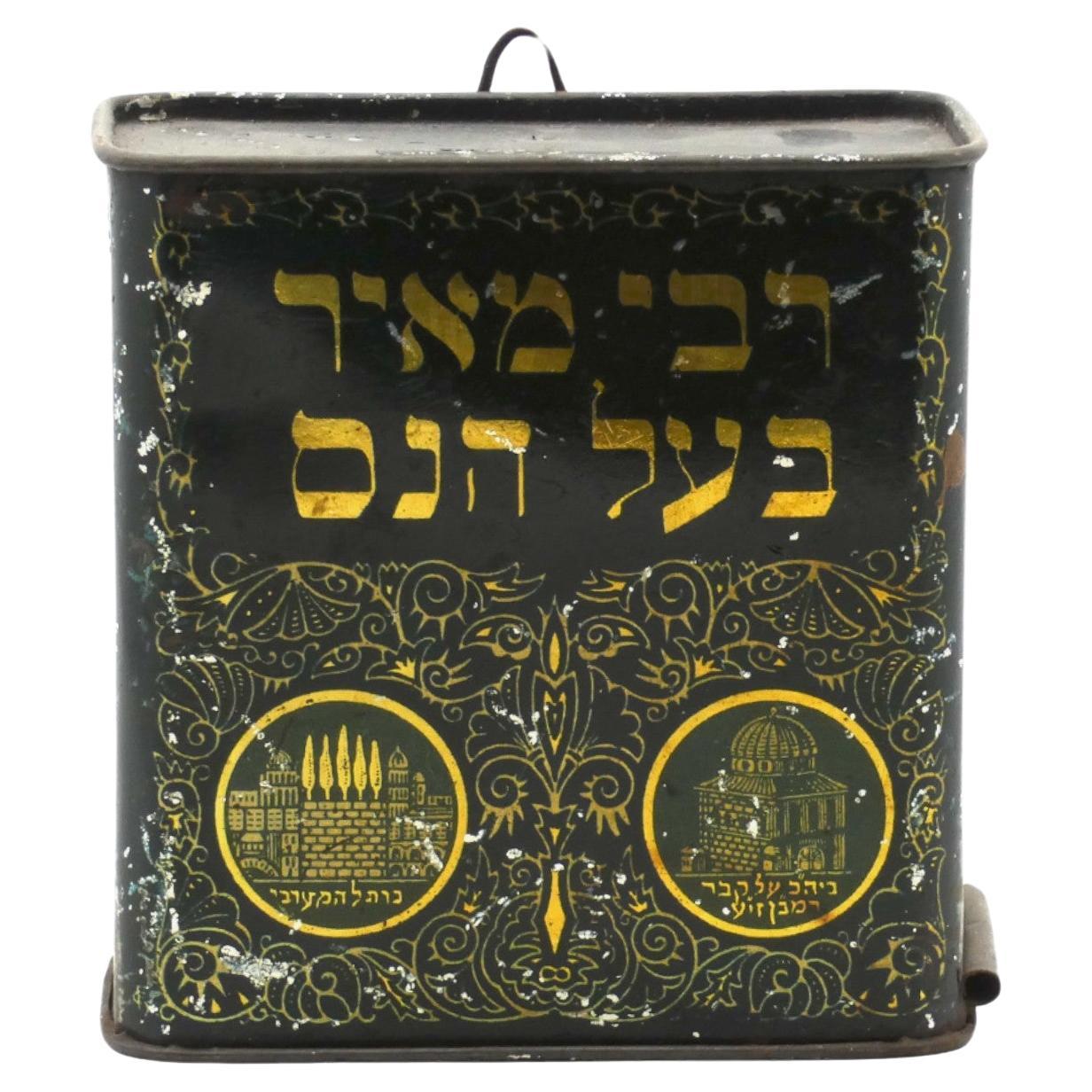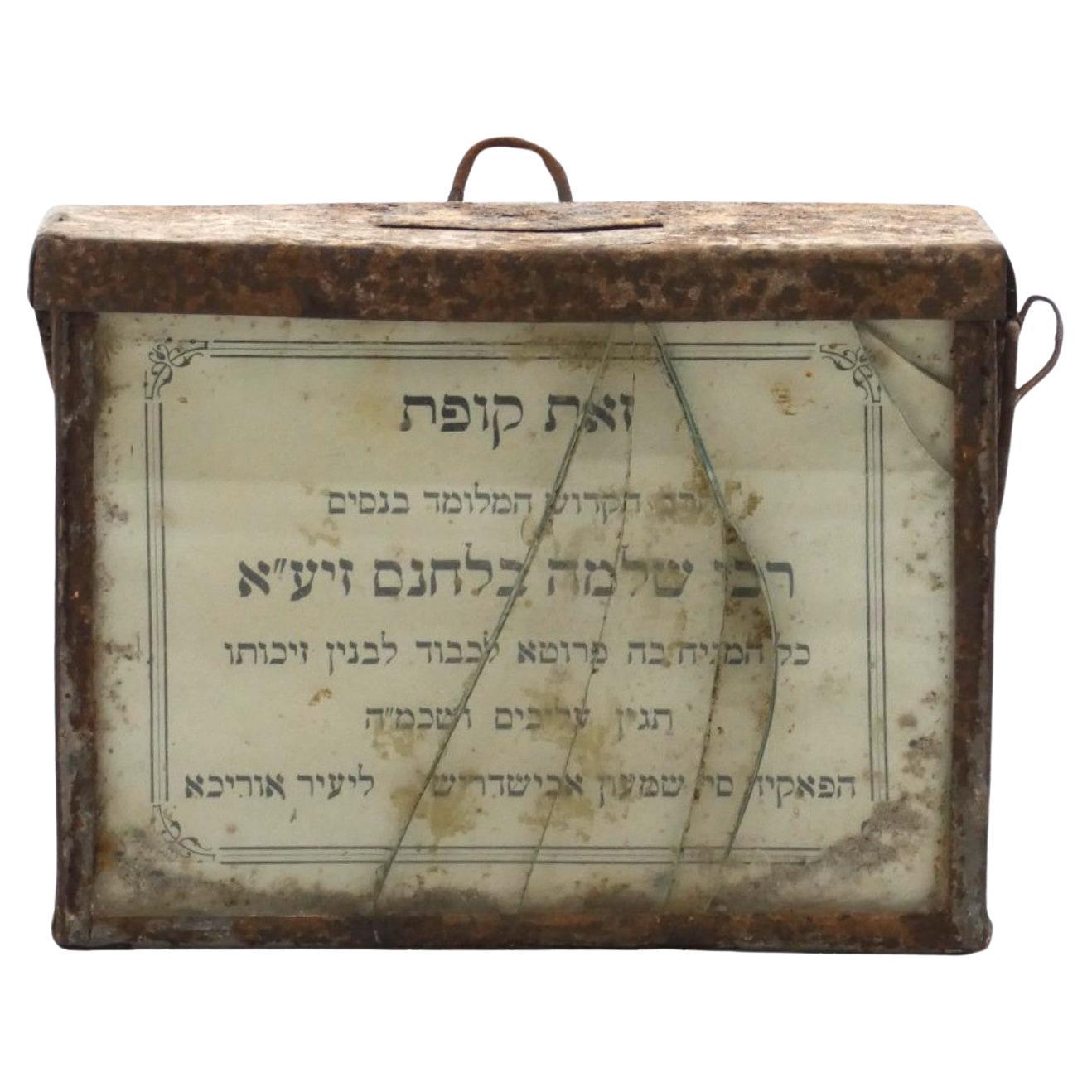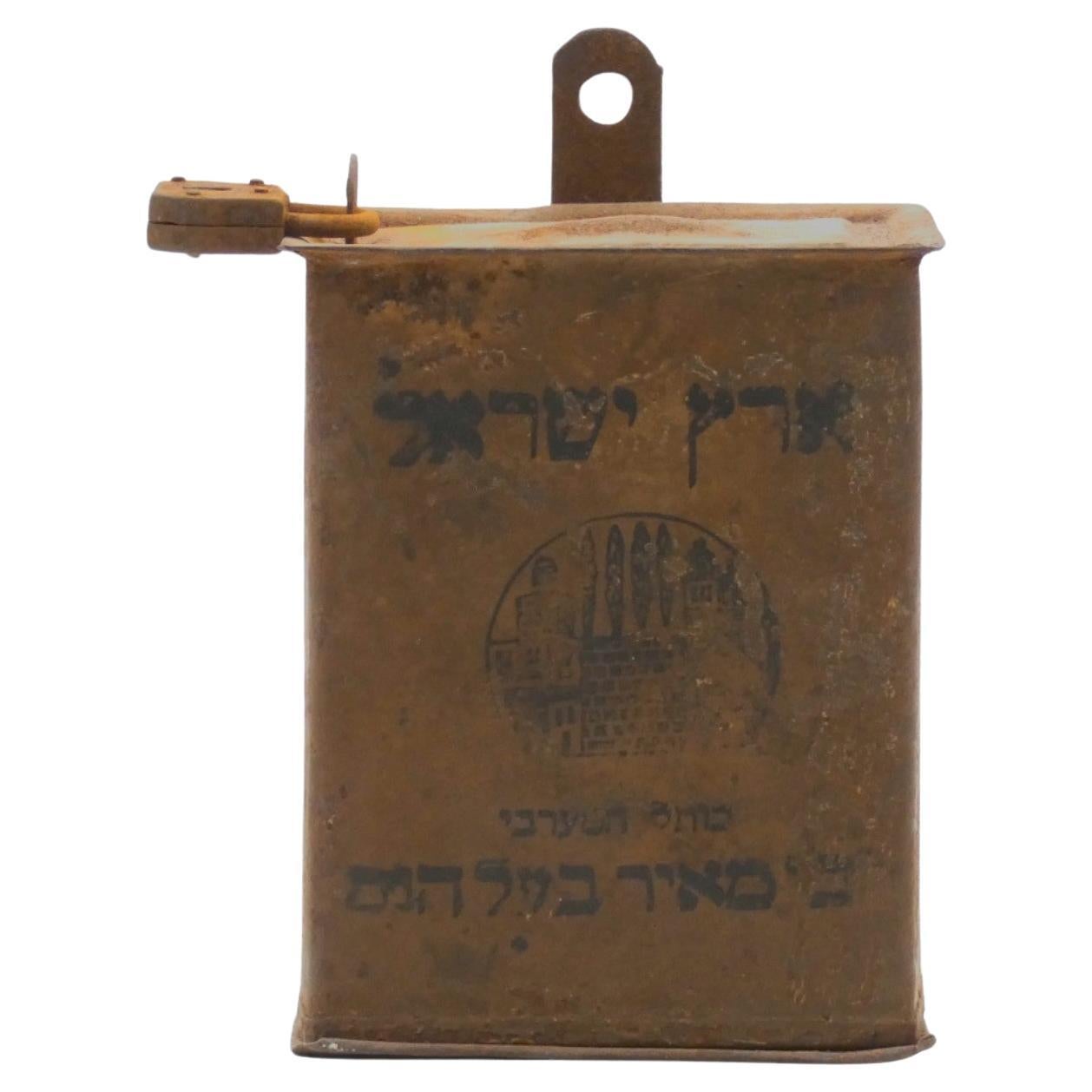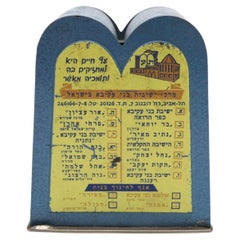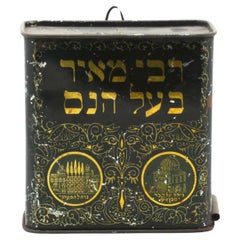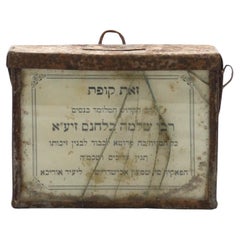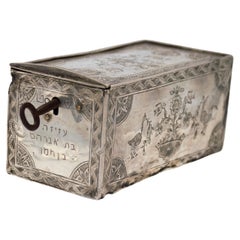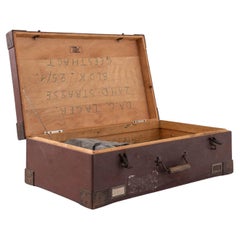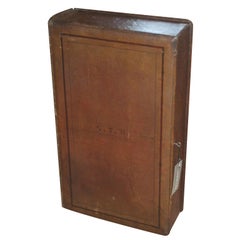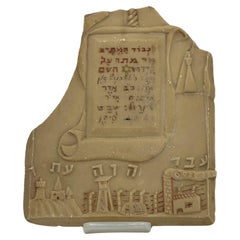Items Similar to Post World War II South African Hebrew Inscribed Metal School Supply Box
Want more images or videos?
Request additional images or videos from the seller
1 of 7
Post World War II South African Hebrew Inscribed Metal School Supply Box
$2,000
$2,50020% Off
£1,511.28
£1,889.1020% Off
€1,749.18
€2,186.4720% Off
CA$2,805.90
CA$3,507.3820% Off
A$3,120.97
A$3,901.2120% Off
CHF 1,637.26
CHF 2,046.5720% Off
MX$38,082.89
MX$47,603.6220% Off
NOK 20,549.62
NOK 25,687.0220% Off
SEK 19,365.52
SEK 24,206.9120% Off
DKK 13,056.89
DKK 16,321.1120% Off
About the Item
Metal school supply box sent by the South Africa Jewish Wars Appeal to the Wels displaced persons (DP) camp in Austria, 1947.
Painted blue and white with the map of South Africa, and Hebrew inscription: "a gift from your brothers and sisters in South Africa", the interior with a pasted printed label entitled "South Africa Jewish appeal, printed by Phoenix, Johannesburg."
- Dimensions:Height: 10 in (25.4 cm)Width: 8 in (20.32 cm)Depth: 3 in (7.62 cm)
- Materials and Techniques:
- Place of Origin:
- Period:
- Date of Manufacture:1947
- Condition:
- Seller Location:New York, NY
- Reference Number:1stDibs: LU5281219172072
About the Seller
5.0
Recognized Seller
These prestigious sellers are industry leaders and represent the highest echelon for item quality and design.
Established in 2006
1stDibs seller since 2020
133 sales on 1stDibs
Typical response time: 8 hours
- ShippingRetrieving quote...Shipping from: New York, NY
- Return Policy
Authenticity Guarantee
In the unlikely event there’s an issue with an item’s authenticity, contact us within 1 year for a full refund. DetailsMoney-Back Guarantee
If your item is not as described, is damaged in transit, or does not arrive, contact us within 7 days for a full refund. Details24-Hour Cancellation
You have a 24-hour grace period in which to reconsider your purchase, with no questions asked.Vetted Professional Sellers
Our world-class sellers must adhere to strict standards for service and quality, maintaining the integrity of our listings.Price-Match Guarantee
If you find that a seller listed the same item for a lower price elsewhere, we’ll match it.Trusted Global Delivery
Our best-in-class carrier network provides specialized shipping options worldwide, including custom delivery.More From This Seller
View AllA Keren Hayeshuv Charity Container, Israel Circa 1940
Located in New York, NY
A Keren Hayeshuv charity container from Israel circa 1940 is an artifact tied to the early years of the State of Israel and its efforts to support Jewish settlement and development.
Keren Hayeshuv, which translates to "The Settlement Fund," was an organization established in Israel during the pre-statehood period and continued its activities after the establishment...
Category
Vintage 1940s Israeli Religious Items
Materials
Tin
A Charity Container for the Bnei Akiva Organization , Israel 1950
Located in New York, NY
A charity container for the Bnei Akiva organization in Israel from around 1950 reflects the ethos and activities of this prominent religious Zionist youth movement.
Bnei Akiva is a ...
Category
Vintage 1950s Israeli Religious Items
Materials
Metal
$1,120 Sale Price
20% Off
A Rabbi Meir Ba'al Haness Charity Container, Israel Circa 1920
Located in New York, NY
A Rabbi Meir Ba'al Haness charity container from Israel circa 1920 is an artifact associated with Jewish religious devotion and charitable traditions.
Rabbi Meir Ba'al Haness, also ...
Category
Vintage 1920s Israeli Religious Items
Materials
Tin
$1,440 Sale Price
20% Off
A Moroccan Charity Container, Circa 1920
Located in New York, NY
This Moroccan charity container from around 1920 is a unique artifact that represents the containers that were often used for collecting donations or contributions for various charit...
Category
Vintage 1920s Moroccan Religious Items
Materials
Tin
$2,000 Sale Price
20% Off
Early 20th Century Austrian Wooden Charity Box
Located in New York, NY
Judaica Charity box, made in Austria, circa 1920.
Printed with a scene of the Western Wall, inscribed in Hebrew “Land of Israel / Western Wall / Rabbi Meir...
Category
Early 20th Century Austrian Religious Items
Materials
Wood
$3,600 Sale Price
20% Off
A Metal Israeli Kotel Charity Container, 1910
Located in New York, NY
A Rare Metal Israeli Kotel charity container for Rabbi Meir Baal Haness from 1910 tied to Jewish religious and charitable traditions.
Rabbi Meir Baal Haness, also known as Rabbi M...
Category
Vintage 1910s Israeli Religious Items
Materials
Metal
$2,000 Sale Price
20% Off
You May Also Like
extremely rare Algerian Judaica silver, jewish Dowry box early 19th century
Located in Tel Aviv - Jaffa, IL
Amazing and scarce JUDAICA object, we have here one of the most touching jewish objects we had for a long time, this small silver dowry box was made in Algeria in the early 19th century, it is all covered with symbols of jewish faith and of couples, the sliding lid has 2 flanking birds with hamsa (protective hand) on each side and a flower vase in the middle.
one side shows two flanking lions with a tree in the middle and the other side shows again two big and two small birds with a flower bowl in the middle, front side has a key hole and next to it there is the Hebrew inscription ס״ט״" which says Siman tov or in English "a good sign" it is taken from the wedding blessing, underneath the lock there is another inscription with the name ״עזיזה בת אברהם בן חמו״ which is the name of the bride, her father and her grandfathers name.
the box is full marked a lot of times with the silversmith mark, every side of the box is marked.
this box was probably ordered by the grooms family to hold the jewelry they are giving to the bride as dowry, this type of objects are rare and there are just a few of them on museum collections.
DOWRY (Heb. נְדֻנְיָה), the property a wife brings to her husband at marriage; the Yiddish equivalent, nadn, is from the same root. The custom of nedunyah became clearly defined and institutionalized only in the talmudic period. In biblical times, mohar (מֹהַר), whereby the groom bought his wife from her father (Gen. 24:53; Ex. 22:15–16; Hos. 3:2), was the accepted practice. It was then customary that the groom give the bride gifts, and that she bring certain property to her husband's home upon marriage: slaves, cattle, real estate, etc. (cf. Gen. 24:59–61; 29; Judg. 1:14ff.; I Kings 9:16). Evidence of the custom of nedunyah is to be found in Tobit (7:14; 8:21) and in the Assuan papyri (Cowley, Aramaic, nos. 15, 18). Gradually, mohar was superseded by the ketubbah custom according to which the husband merely assumed the responsibility of compensation to his wife in case he divorced her: he had to pay her 200 zuzim if she had been a virgin at the time of marriage, and 100 zuzim if a widow or divorcée (see *Ketubbah).
By talmudic times, the institution of nedunyah was prevalent; the father gave a dowry to the bride since the daughter was excluded from paternal inheritance. Fifty zuzim (equivalent to the worth of 180 grams of silver) was the minimum amount a father was obliged to give to his daughter (Ket. 6:5). Parents usually gave much more, according to their social standing. Community funds provided the dowry for an orphan or a very poor girl (ibid.; cf. Sh. Ar., YD 251:8). In case of her father's death, the brothers of a minor girl were obliged to give her the minimum dowry, and the court estimated how much her father would have given her above the minimum dowry. The sum was then taken out of the father's estate and given to the daughter upon majority (Ket. 6:6; 68a–69b). In the absence of such an estimate, each daughter was entitled to receive one-tenth of the value of her father's estate in money, or in valuables (Yad, Ishut, 20:4–7; Sh. Ar., EH 113:4). If the father was unable or unwilling to pay the promised dowry at the betrothal ceremony, the groom could refuse to marry his bride (Ket. 13:5; Ket. 108b–109a). Insistence on exact payment of the promised dowry, however, was frowned upon by later rabbinic authorities (Rema to Sh. Ar., EH 2:1). In certain communities it was customary for the groom's father to make a dowry contribution equal to that of the bride's father (Ket. 102b). The dowry, whether given in real estate, slaves, money, or chattel was recorded in the marriage contract (the ketubbah) and in some instances one-third or one-fifth of the actual value of the dowry was added to the sum mentioned in the ketubbah. Based upon a decree enacted by *Simeon b. Shetah (first century C.E.), the Talmud ruled that the husband and his entire property were liable for compensation as stipulated in the ketubbah, either in case he died (when she collected the sum specified in the ketubbah from the heirs) or in case he divorced his wife (Ket. 82b). For the status of the dowry and the husband's rights and obligations, see below. The rabbinic enactments (Takkanot Shum) by R. Jacob *Tam and by the rabbinic synod of the communities of Speyer, Worms, and Mainz (Germany) stipulated that if a woman died...
Category
Antique Mid-19th Century Algerian Tribal Art
Materials
Silver
20th Century German Plein-Air-Artist's Wooden Case
Located in High Point, NC
This 20th-century wooden case is a genuine gem for enthusiasts of plein-air art sessions. Handcrafted in Germany, the suitcase is protected by metal corners that accentuate its plato...
Category
20th Century German Decorative Boxes
Materials
Metal
Early 20th Century Leather Faux Book Box, United Kingdom
Located in Napa, CA
Large leather book box with lock and key. Book is bound with leather and stamped G.T.H.
Category
Early 20th Century British Boxes
Materials
Metal
Historic Rare Carved memorial plaque made by Jewish internee in Cyprus, 1948
Located in Tel Aviv - Jaffa, IL
super rare and historic example of Cyprus stone carving, made by jewish holocaust surviver that was Detained at the Internment camps in Cyprus, just 3 years after the holocaust. this piece is very unusual, most of this carvings shows us aspects of living in the Refugee camps or zionist views of israel, sometimes they even made judaica objects like menorahs Or Candlesticks, but its rare to find memorial plaques such as the example in front of us, the plaques was Damaged In the way to israel and two pieces from the upper section were broken off, the middle part of the Plaque shows a Scroll shaped memorial plaque with the inscription : "for the dead who died on the name of god" In red color, the middle has a yellow star carved and painted, just like the yellow star jewish...
Category
Vintage 1940s Cypriot Antiquities
Materials
Soapstone
Vintage 1930s Bakelite Box, 1930s
Located in Roma, IT
Vintage Linsden Art Deco Bakelite Box, Half Moon Swivel Mechanism, Dispenser/Container.
Brown/Orange Marble. 1930s
Good condition.
Category
Vintage 1930s Italian Decorative Boxes
Materials
Bakelite
1950s South African Branded Produce Crate
Located in Hook, Hampshire
1950s South African Branded Produce Crate
1950s South African Branded Produce Crate. Good honest produce crate with distinct branding.
WORKSHOP REPOR...
Category
Vintage 1950s European Decorative Boxes
Materials
Wood
More Ways To Browse
Used Post Box
South Africa
World War Ii Furniture
World War Map
Vintage Furniture Johannesburg
Inlaid Wood Box
Antique Engine
Decorative Tray With Handles
Small Antique Silver Boxes
Wood Box Art Deco
Locking Wood Box
Mother Of Pearl Shells
Bronze Box Large
Carved Wooden Box
Art Deco Shagreen Box
Tortoise Antique
Antique Iron Box
Brass Carved Boxes
